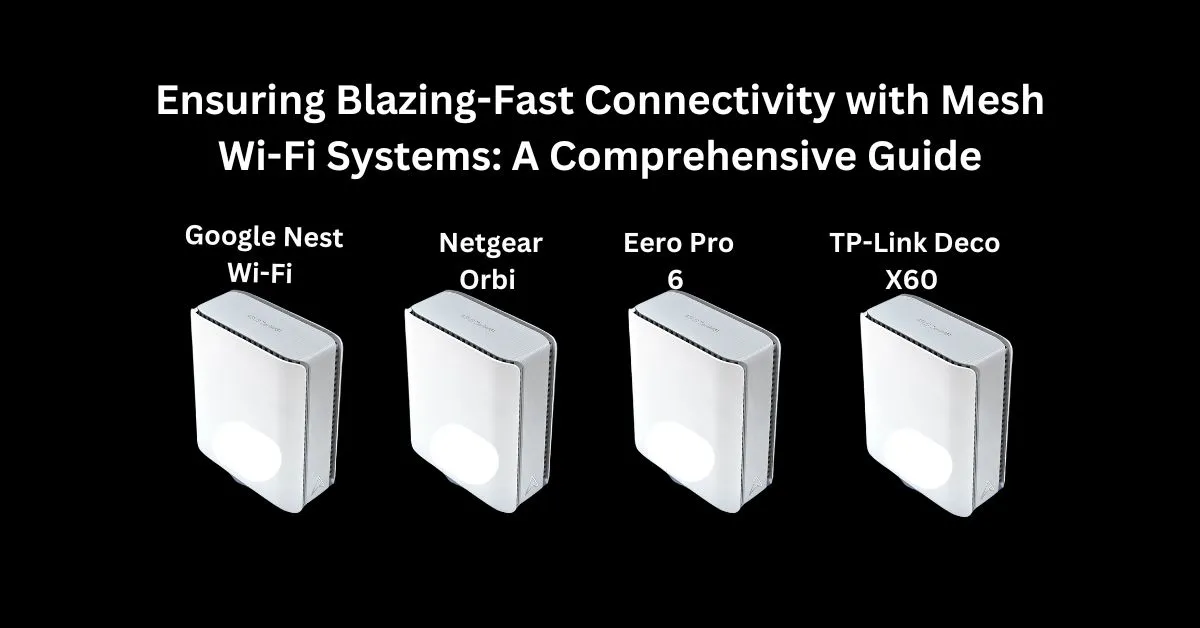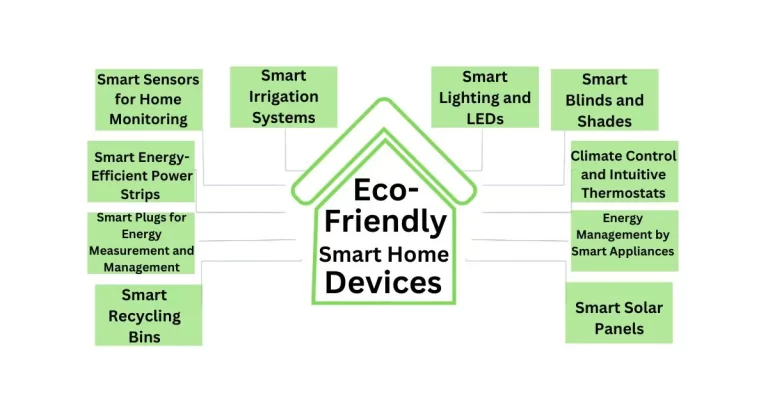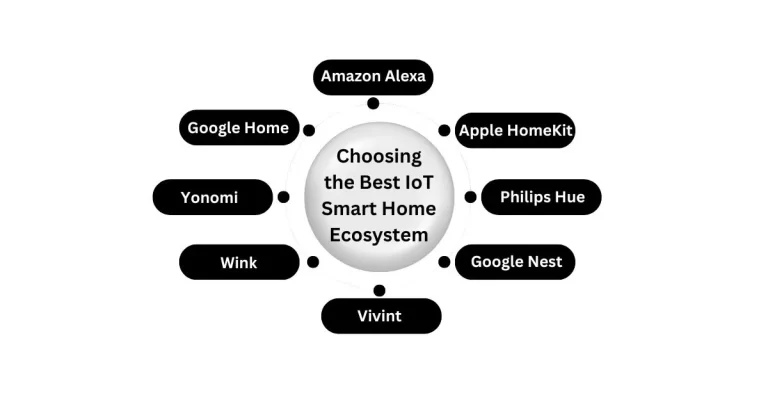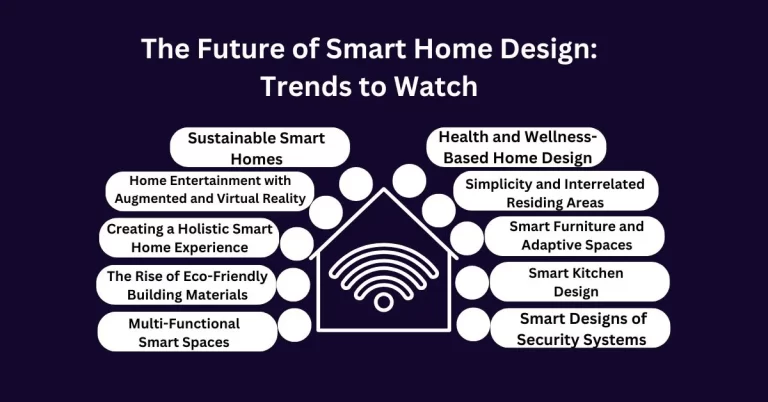Fast Connectivity with Mesh Wi-Fi Systems : A Comprehensive Guide
Mesh Wi-Fi systems are formed by a main Wi-Fi router and one or more satellite nodes that extend the coverage area of a single network. These systems enable handoff for associated devices, which immediately transfer to the router or satellite offering the best signal in a given area.
Mesh Wi-Fi systems are most helpful in large residences or offices that would need more than one router to provide sufficient signal strength. Since satellite nodes can be placed anywhere, mesh Wi-Fi systems do not have blind spots throughout the environment, and the signal strength is equal across the entire space. A mesh network is a type of Local Area Network or LAN where interconnected nodes actively cooperate to deliver a strong Wi-Fi signal throughout expansive areas.
Typically, a mesh network can consist of a primary node central to various satellite nodes, or it can consist of an individual mesh node made up of numerous nodes. Unlike the normal Wi-Fi extenders, the mesh systems are a single network under one login, making it easy to access from all the nodes.
Each mesh node can directly interact with connected devices such as smartphones, smart home devices, smart TVs and tablets and other nearby nodes as well. This interconnected structure helps to switch from one device to another smoothly from node to node for efficient and efficient working.
For instance, the “NETGEAR Orbi” Mesh Wi-Fi Systems deploy a separate Wi-Fi band for the network transmission known as backhaul and use the Tri-Band or Quad-Band where fast speeds even where several devices are connected are crucial and possible.
What is a Mesh Router?
The mesh router is the main part of a mesh Wi-Fi system that connects multiple satellite nodes to the main router. When connected to a modem, the mesh router creates a single network in a residence or workplace by linking to and controlling satellite nodes. On one hand, satellites rely on the principal router for their operation; on the other hand, the point router can function in case of necessity or need.
It is difficult to achieve good Wi-Fi signals in big houses or houses with thick walls and many rooms. Mesh Wi-Fi systems provide a strong answer to guarantee that you have a quick and stable connection in your area. This article examines how mesh Wi-Fi systems work, their key benefits, setup guidance, and factors to consider when selecting the best mesh system for your connectivity needs.
What is a Mesh Wi-Fi System?
A mesh Wi-Fi system is a sophisticated network solution that aims at offering the coverage of Wi-Fi in large spaces by using several connected nodes, which are known as satellites or access points. Unlike usual routers that perform a signal broadcasting by a single device, mesh Wi-Fi systems use several nodes interconnected. This arrangement makes Wi-Fi signals be distributed evenly within the space and thus eradicating black spots.
How Mesh Wi-Fi Systems Function
In a mesh system, each node is connected, and all of them work together to support a single network. Devices can move from one node to another without any disruption of the internet connection when users are moving from one room to another. This is usually located near the source of the internet connection while other nodes are placed at a central point in the house or office to ensure there is a good signal. These nodes interact with each other or they report back to the main router hence making data transfer easy in the network.
Key Benefits of Mesh Wi-Fi systems
There are several benefits of using Mesh Wi-Fi systems over traditional routers, particularly in large or complicated areas. Here are some core benefits:
1. Seamless Coverage
Mesh systems get rid of Wi-Fi blind zones, and this means that you will always get a strong signal regardless of the design of your home or the thickness of the walls in your building. The devices can freely move across the space and as they do, they only connect to the node with the strongest signal, thus ensuring that there is connectivity in all the areas.
2. Reliability of Speed and Performance
Range extenders are known to cause slower speeds because of data repealing, while mesh systems provide equal speeds. The technologies within mesh systems are adaptive and can manage bandwidth to ensure that even when many devices are connected, the connection speed is fast.
3. Easy Setup and Scalability
Mesh systems are usually easy to set up, often through a smartphone app, so anyone can do it, even without much technical know-how. Additionally, they are highly scalable, allowing users to add nodes to increase coverage as needed.
4. Enhanced Security
There is also good news that most mesh Wi-Fi systems come with high levels of security, including WPA3 encryption, automatic firmware updates, and malware protection. These features protect your network from any possible cyber threats to make your browsing more secure.
5. Automated Traffic Control
Most mesh systems have intelligent traffic control, which makes some traffic or devices more important, which means that during peak hours, streaming, gaming, or video calls will not suffer.
Key Benefits of Mesh Wi-Fi systems
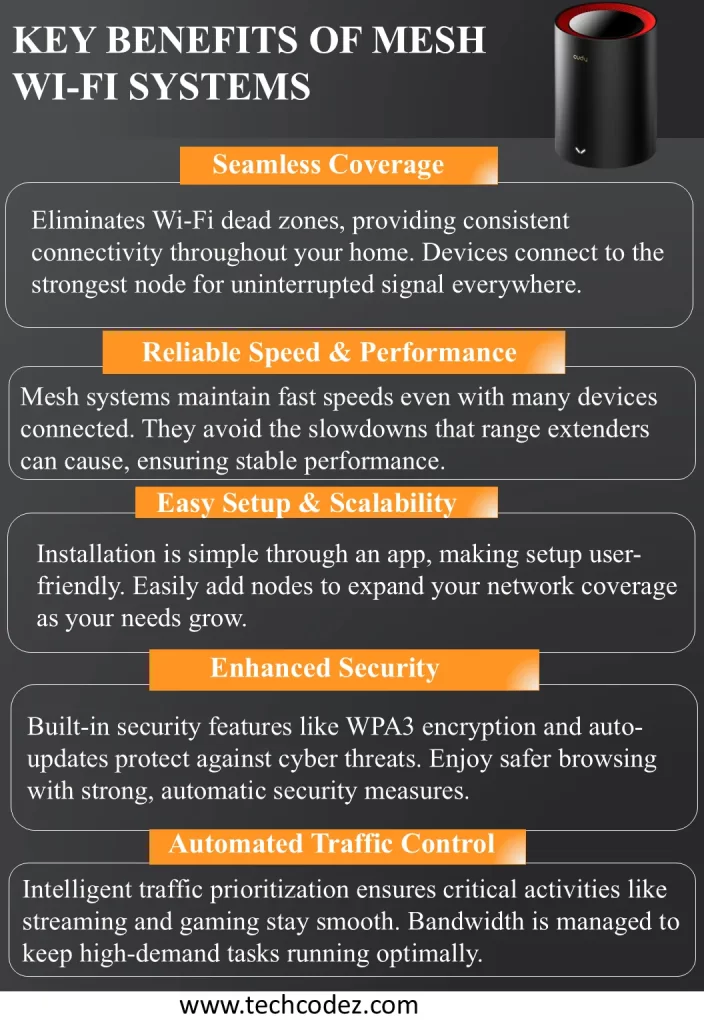
A Beginner’s Guide to Install Mesh Wi-Fi Systems
Installation of a mesh Wi-Fi system is usually easy, and most systems offer intuitive installation through an app on a smart device. Here are details on how to set up your mesh Wi-Fi for optimal performance…
- Position the Main Router: Place the main router close to your internet modem, and if possible at the center of your house. The installation of the mesh system should be done effectively to ensure that the whole coverage area and efficiency is considered.
- Strategically Place the Nodes: Place position nodes in various areas of your home. Do not put them close to the walls, metals, or large electronics which might disrupt the signal interference. A rule of thumb is here to ensure nodes are placed 30-40 feet apart to achieve the best signal range.
- Use the Mobile App: Many mesh systems come with a mobile application that helps you through the process of setting up the system. The app enables one to join nodes, set the network name/SSID and set up security.
- Test Coverage and Adapt if Necessary: After this, check the coverage in different areas of your space/home/farm or office. If there are any gaps observed, attempt to rearrange the nodes or increase the number of nodes to enhance the coverage area.
- Enable Security Features: Some of the network security to set include WPA3 encryption. It enhances the security of the wireless connection. Use available options such as guest networks and parental control if present to improve the network.
Factors to Consider When Choosing a Mesh Wi-Fi System
Several important factors determine an appropriate mesh Wi-Fi system, including the dimensions of the home, the usage of the internet, and the cost. Below here mentioned are fundamental aspects to evaluate:
- Coverage Area: Check that the system is powerful enough to cover the size of your home as some models are designed for large houses, while others are designed for medium-sized houses.
- Device Capacity: Some systems can handle more devices than others. Search for systems with high-performance indicators.
- Advanced Security Features: Make sure that the mesh system has the needed security measures such as WPA3 encryption, auto update and any other security upgrades.
- Budget and Scalability: Determine or figure out its cost during the beginning of its use and whether you can integrate more nodes if your coverage requirements are likely to increase in the future.
- Performance Enhancing Features: For better performance, one should look at systems that include traffic prioritization and dynamic bandwidth allocation.
- Speed Compatibility: Before further proceeding, you need to ensure that the number of extended Wi-Fi points matches the speed of the purchased internet. For example, if you have a gigabit connection, select the system supporting gigabit speeds to guarantee the absence of any limits for data transfer.
When you have many devices connected at once in your home, it becomes essential to choose a mesh system with higher bandwidth capability. It should be able to support multiple connections and at the same time should not slow down the internet connection.
Advanced Functionalities
Mesh Wi-Fi systems should have extra functionalities such as MU-MIMO for efficient client control, tri-band for improved speed, and several security measures to protect your network.
Brand credibility and customer support are two of the most important factors for any business.
Purchase mesh Wi-Fi brands that have good quality and stability such as Google Nest, Eero, and Netgear Orbi. Ensure that the brand also has good customer relations and that the firmware is frequently updated to improve the system’s functionality and security.
Leading Mesh Wi-Fi Systems
Here are the highly rated mesh Wi-Fi systems, recognized for their performance, usability, and features:
Google Nest Wi-Fi
This system is appreciated for its simple app and its unbroken compatibility with Google Assistant, making it a good choice for smart home installations because of this system’s coverage and reliability.
Netgear Orbi
It is a tri-band with fast internet speeds, making it ideal for use in big houses and fast internet connections with steady speed on multiple devices.
Eero Pro 6
Eero Pro 6 is Amazon’s primary mesh system, which supports Wi-Fi 6 and is easy to set up. This makes it perfect for homes with Alexa since it is compatible with this gadget.
TP-Link Deco X60
This system offers an affordable option to get into Wi-Fi 6 and is ideal for mid-sized homes. It also has parents control options and security options for a safer internet connection.
Best Practices to Optimize Mesh Wi-Fi System
To fully leverage your mesh Wi-Fi system’s capabilities, consider these optimization strategies in your tasks:
- Maintaining a current version of the system firmware is beneficial for achieving the highest system performance as well as for protection against possible attacks. If possible, turn on the auto-update option.
- Reduce the number of associated devices and apply traffic shaping to BayaaS devices or applications that need more bandwidth.
- If possible, link nodes using Ethernet backhaul to avoid Wi-Fi channels getting congested, especially for activities such as streaming and gaming.
- The nodes are to be located at distances from areas that can interfere with the signal from microwaves or cordless phones etc.
Advantages and Disadvantages of Mesh Networks
Advantages
Mesh Wi-Fi systems hold several advantages over traditional routers and extenders:
- They provide fast and easy internet connectivity to consumers/users and are capable of giving more than the ability of a single router.
- These systems can fully unlock the potential of the gigabit-level or higher internet connection.
- A strong build system allows for additional features in mesh routers such as security features and even control of the kid’s/children’s content.
- These systems are expandable, allowing additional satellite nodes to be integrated to eliminate weak Wi-Fi spots at the edges of coverage areas.
Disadvantages
Despite their advantages, there are a few limitations/disadvantages or cons for mesh network buyers:
- Devices may experience little delay as data is transferred across the satellite nodes and each node adds a small amount of delay due to the relay processes. Nevertheless, this latency is often negligible and balanced with the decreased device load per node in contrast with the routers.
- Mesh Wi-Fi systems are known to be costly or pricy relative to a single router with similar performance characteristics. More economical in the long run because they do not require several extenders and network configuration processes.
Conclusion
A mesh Wi-Fi system is one of the best options for homeowners who want fast and reliable internet connection. These systems reduce blind spots, increase the speed of the networks, and offer scalability solutions making homes smart connected spaces. In choosing a mesh Wi-Fi system consider the layout of your house, internet needs and usage to determine which one fits your needs best. If you have the right mesh Wi-Fi system then you can have a smooth or uninterrupted connectivity in every corner or inch of your house, no more slow connections and buffering.
FAQ
Does a mesh Wi-Fi system improve internet speed?
A mesh Wi-Fi system helps eliminate dead zones and provide better coverage but does not make your internet faster than what you subscribed to. But it can enhance the efficiency of the current speed by enhancing the signal distribution.
What is Wi-Fi 6?
It is known as 802.11ax, is a wireless network that offers faster, more efficient data transfer than previous Wi-Fi generations.
What number of nodes is required for the best coverage?
This depends on the size of the house. In general, a one or two-node router is more than enough for homes. In large houses, it may be necessary to use more nodes to provide coverage.
Can mesh Wi-Fi be used with any internet service provider?
Certainly, however, not every mesh Wi-Fi system is compatible with every internet service provider. Ensure that your modem supports the internet speeds included in your subscription.

